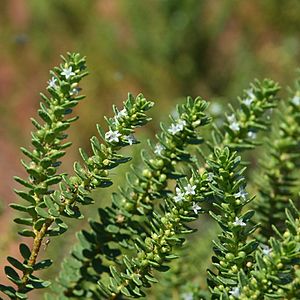Pale myoporum facts for kids
Quick facts for kids Pale myoporum |
|
|---|---|
 |
|
| Myoporum brevipes growing in South Australia | |
| Scientific classification | |
| Genus: |
Myoporum
|
| Species: |
brevipes
|
The Myoporum brevipes, often called the pale myoporum, is a plant that belongs to the figwort family (Scrophulariaceae). This plant can grow in different ways. Sometimes it spreads low to the ground, and other times it stands up tall like a small bush. Its branches and leaves have small bumps, like warts. It grows pretty white or pink flowers, which often have spots. After the flowers, it produces juicy white fruits. You can usually find this plant in dry areas of South Australia, but it also grows in Victoria and Western Australia.
Contents
What Does the Pale Myoporum Look Like?
The pale myoporum is a shrub that can be either low and spreading (called prostrate) or tall and upright (called erect). It can grow up to about 2 meters (6.5 feet) high. Its branches and leaves are covered in small, wart-like bumps called tubercles.
The leaves grow one after another along the stem. They are thick and often feel a bit fleshy. They can be from 2.5 to 28 millimeters (about 0.1 to 1.1 inches) long and 1.2 to 8 millimeters (about 0.05 to 0.3 inches) wide. Their shape can vary, but they are often egg-shaped, with the narrower part closer to the stem.
Flowers and Fruits
The flowers grow in groups of 1 to 5 where the leaves meet the stem (these spots are called axils). Each flower has 5 sepals (small, leaf-like parts that protect the bud) and 5 white or pink petals. The petals join together at their base to form a tube. Often, these petals have pink or purple spots.
The flower tube is about 1.5 to 5.5 millimeters long, and the petal tips are about 1.5 to 3.5 millimeters long and also have small bumps. Inside the flower, there are 4 stamens (the parts that make pollen), which stick out beyond the petals.
The pale myoporum usually flowers between October and February. After the flowers bloom, they turn into white fruits. These fruits are called drupes, which means they have a fleshy outer part and a hard seed inside, like a peach or cherry. They are about 2.5 to 6.5 millimeters (about 0.1 to 0.25 inches) across and can be oval or round.
How Was the Pale Myoporum Named?
The scientific name for this plant, Myoporum brevipes, was first officially described in 1870. This was done by a scientist named George Bentham in a book called Flora Australiensis. He described it from a plant sample collected during an expedition by John McDouall Stuart.
The second part of the plant's name, brevipes, comes from two Latin words: brevis, which means "short," and pes, which means "foot." This name probably refers to the short stalks that hold the flowers (called pedicels) on the plant samples that George Bentham studied.
Where Does the Pale Myoporum Grow?
The pale myoporum is found mostly in South Australia. However, there are also a few small groups of these plants in Western Australia. It is very rare in Victoria, with only a few plants found near a place called Boinka.
This plant likes to grow in sandy soils that contain calcium carbonate (a common mineral found in rocks and shells). You can often find it on sand dunes or close to salty lakes. It can also grow in places that have been disturbed, like along roadsides.
Is the Pale Myoporum in Danger?
In Western Australia and South Australia, the pale myoporum is considered not threatened, which means there are enough of them, and they are not in danger of disappearing. However, in Victoria, this plant is classified as endangered. This means there are very few of them left, and they are at high risk of dying out if we don't protect them.

